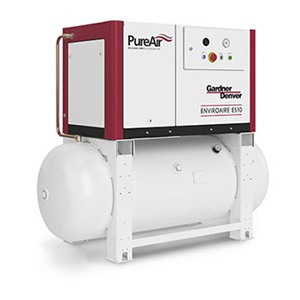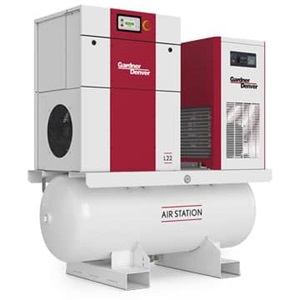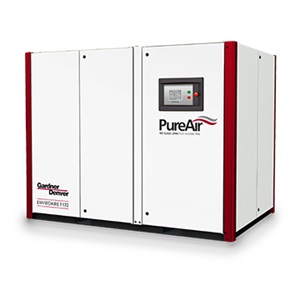Select Your Country/Region
Current Region:
 Global (EN)
Global (EN)
Choose a different country or region to see the content specific to your location
- ARTICLES
- All Articles
- TYPES OF AIR COMPRESSORS
How can we help you?
In layman's terms, an air compressor is a device which intakes air (or gas) at a lower pressure and compresses it to deliver the air at a higher pressure. Effectively, a blower is designed to squeeze air and gas to perform a specific function. Air compressors have a wide range of functions across a number of industries, including: food & beverage, pharmaceuticals, automotive, construction, manufacturing, agriculture, engines, energy, etc. Air compressors are typically used when the pressure requirement falls higher than that of a fan or of a compressor. The type of air compressor that is best suited for your needs will depend on a variety of factors, including the amount of power you need, the size of your space, and the types of tools or equipment you plan to use.
While there are a number of air compressor types, there are also natural gas compressors. Learn more about gas compressors and the wide range of industrial applications gas compressors serve at LeROIgas.com . However, this article will highlight our main types of air compressors, focusing on their benefits and functions that are suited toward specific applications:
Reciprocating air compressors (also sometimes known as piston compressors) are compressors which achieve high pressure through the use of pistons controlled by a crankshaft. This works by way of air (or gas) entering the device, which is driven in a reciprocating motion via a crankshaft, and then discharged from the device. Pressures of up to 5,000 PSIG are commonly produced by multistage reciprocating compressors.
Applications include: oil refineries, gas pipelines, offshore platforms, refrigeration plants, etc. One specialty application is the blowing of polyethylene terephthalate (PET) plastic bottles. While rotary screw compressors are used for high volumes of air, reciprocating compressors are more typically used in high pressure requirements.

A rotary scroll air compressor is a type of positive displacement compressor that uses two spiral-shaped scrolls, one fixed and the other moving in an eccentric orbit, to compress air. As the moving scroll orbits around the fixed scroll, it creates a series of gas pockets that gradually decrease in volume, causing the air to be compressed. The compressed air is then discharged through a port in the housing, while the low-pressure air is drawn in through another port.
Unlike other types of compressors, such as reciprocating compressors or rotary screw compressors, the rotary scroll compressor has a continuous, smooth compression process that results in very little pulsation or vibration. This makes it ideal for applications that require a steady flow of compressed air, such as in medical equipment, electronics manufacturing, and food and beverage production. Rotary scroll compressors are highly efficient and reliable, with low noise levels and minimal maintenance requirements. They are also oil-free, which makes them suitable for applications where clean air is critical, such as in the pharmaceutical industry.

In rotary screw air compressors, compression is achieved by way of two internal screws rotating in opposite directions, which trap and compress air between them. Equipped with an internal cooling system, these compressors require a low level of maintenance and therefore are commonly used in a number of applications. Because of this internal cooling system, these air compressors are designed for continuous use, and range in power from 5 HP up to 500 HP. Additionally, these devices can be lubricated with oil or can operate oil free for applications that require contaminant free air.
Rotary screw compressors are typically used when large volumes of compressed air are required; such applications include chilling or powering tools which require larger volumes of air to drive them e.g. jackhammers and impact wrenches. For higher pressure requirements, reciprocating compressors are typically used, which leads us to our next entry.

Rotary vane air compressors are a popular type of air compressor that can produce a high volume of compressed air while using relatively little energy. This makes them an ideal choice for businesses and industries that require a lot of compressed air but want to keep energy costs low. Rotary Vane Air Compressors have the lowest oil carry over (only 2 ppm). Before the vapor is introduced into the separators, a multilevel internal separation system is used. This means less downtime for your operations and more productivity overall.
These machines are compact, simple, robust and engineered to meet the most stringent of specifications. They are commonly used in a variety of applications, including manufacturing, automotive repair, construction, dentistry and packaging.

The main difference between oil-lubricated, oil-free and oil-less air compressors is how they lubricate, seal and cool rotating components within the machine. Oil-lubricated compressors utilize oil injected into the compression chamber to seal the space between the rotors and to cool the compressor thereby increasing the compressor efficiency. Oil-free compressors, by definition, do not inject oil into the compression chamber. They do use oil to lubricate bearings and gears, however no oil comes in contact with the compressed air stream. This creates compressed air that is free of any oil contamination, which can be critical for many industrial processes. Oil-less compressors are a subset of oil-free compressors and do not use any oil whatsoever. They utilized bearings that are permanently lubricated and do not require any sort of external oil lubricating system.
Oil lubricated air compressors are machines that compress air using oil as a lubricant to help the internal parts move smoothly and reduce wear and tear. In an oil lubricated air compressor, the pump's internal components are coated in oil to reduce friction and heat, which helps to extend the lifespan of the compressor. The oil also helps to trap any contaminants that may be in the compressed air, which is important for applications that require clean, dry air. Oil lubricated air compressors often require regular maintenance to ensure that the oil is clean and at the correct level. Over time, the oil can become contaminated with dirt and debris, which can reduce the compressor's efficiency and lifespan.

Oil lubricated air compressors are machines that compress air using oil as a lubricant to help the internal parts move smoothly and reduce wear and tear. In an oil lubricated air compressor, the pump's internal components are coated in oil to reduce friction and heat, which helps to extend the lifespan of the compressor. The oil also helps to trap any contaminants that may be in the compressed air, which is important for applications that require clean, dry air. Oil lubricated air compressors often require regular maintenance to ensure that the oil is clean and at the correct level. Over time, the oil can become contaminated with dirt and debris, which can reduce the compressor's efficiency and lifespan.

Oil-free air compressors are designed with special coatings and materials that help increase the efficiency of the compressor without requiring oil to be injected into the compressor. This eliminates the risk of oil contamination downstream. These compressors are ideal for applications where oil contamination is a concern such as in the manufacturing of food & beverages, pharmaceuticals, semiconductors, etc. Oil-free compressor technologies include rotary screw, rotary scroll and some reciprocating designs. Of these, both rotary scroll and some reciprocating are oil-less technologies.

Oil-less air compressors are designed with special coatings that do not require lubricating oil. These compressors rely on dry compression technology, which eliminates the need for oil by using materials that are naturally self-lubricating, such as PTFE.
In terms of performance, both oil-free and oil-less air compressors can produce high-quality compressed air suitable for a wide range of applications.

After covering the main types of air compressors, it can be stated that there is no clear answer as to which type is the best. As they each offer various benefits and drawbacks, it ultimately depends on your application and business needs. For instance, whilst rotary vane compressors are compact and suitable for construction and dentistry, reciprocating compressors are used when high-pressure requirements are needed, such as the blowing of polyethylene terephthalate (PET) plastic bottles.
At Gardner Denver, we offer a wide range of air compressor products in various configurations.
Visit our Compressors product page to discover our full range of products, and learn more about how our technologies could best suit your application needs.